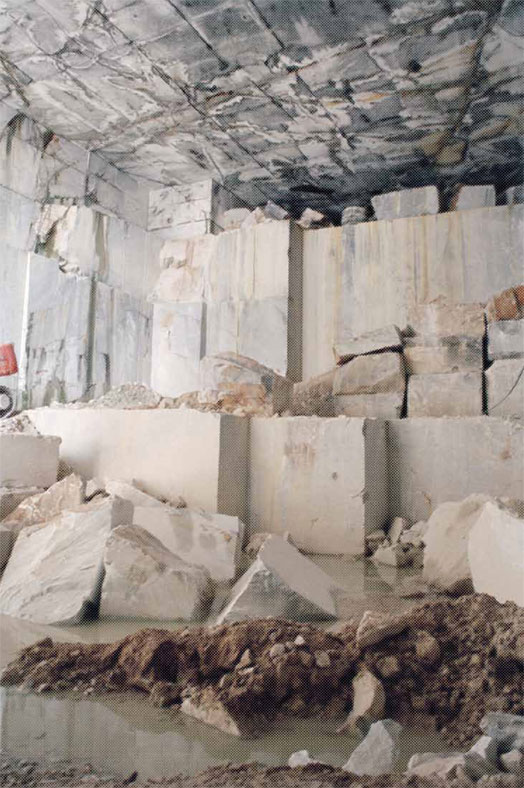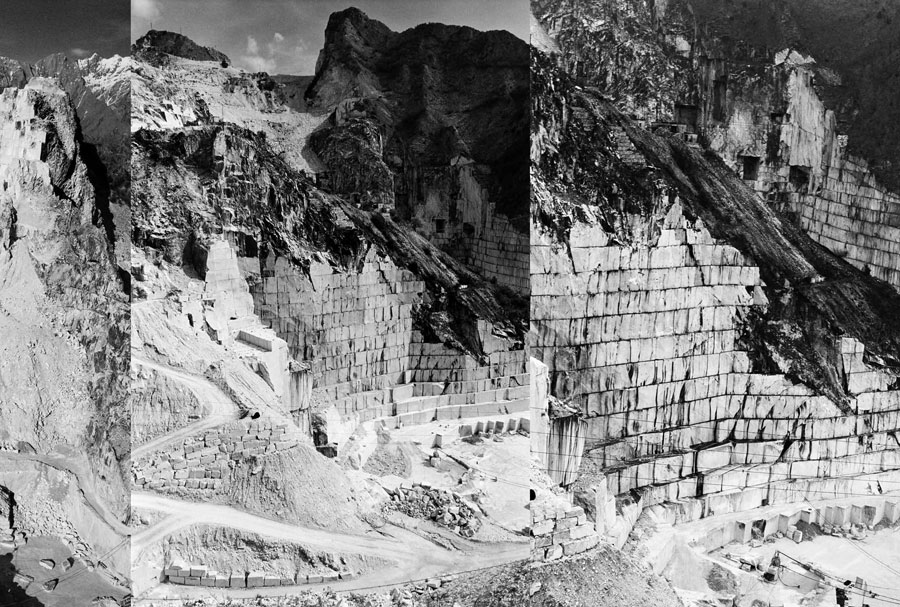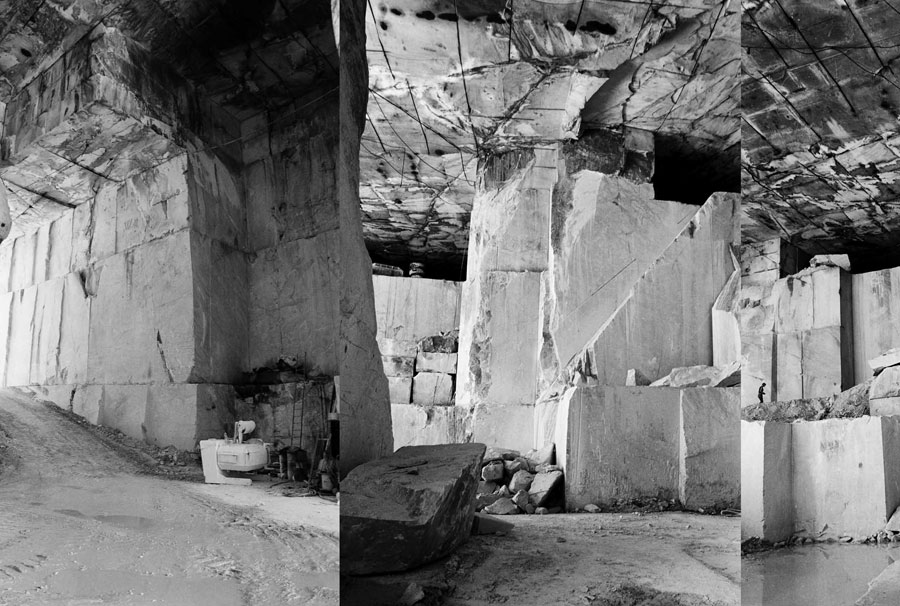AGLAIA KONRAD – CARRARA
isbn 9789077459669 ROMA PUBLICATIONS
Idea Code 11462 €26,00
Aglaia Konrad uses film and photography to visually extend her interest in urban development, cityscapes and architecture. In this artist book she presents photographs taken in the Carrara region in Italy between 2008 and 2010, along with the 16mm film ‘Concrete * Samples III – Carrara’.
136 p, ills colour & bw, 16 x 24 cm, pb, English
Think Space Removal /Informed Dust /Landscape
By Angelika Stepken
extract :
“Located at the foot of the Apuanian Alps, this city owes its fame to the white marble found here.” This is roughly how every travel guide on Carrara begins. The city of 65,000 inhabitants is situated approximately 60 miles northwest of Florence on the Versilia coast, which extends 18 miles south to Viareggio, Tuscany’s fashionable swimming resort since the late 18th century. Each year, around 2.5 million tourists, including a recent boom in Russians, flock to the privatized sandy beaches to catch a tan with the Apuanian Alps in the background, whose peaks are as high as 1,800 meters. Motorists can see the “white gold” on the distant mountains as soon as they turn into the long access road from the sea that leads to Carrara; it always looks like snow, regardless of the season. Marble is precious; marble—particularly the white Statuario of Carrara—has helped write art history, having provided the material for classical sculpture from the Greeks to the present day. Since the 1960s, for instance, the American grand dame of contemporary sculpture, Louise Bourgeois, has repeatedly worked with white Carrara marble in the ateliers of the neighboring Pietrasanta.
Marble is also heavy, hard, and costly; mining it is difficult. The three main marble basins of Carrara—Ravaccione, Fantiscritti, and Colonnata—contain around 150 quarries and can be reached by car or bus. The mountains harbor a wealth of reportedly 60 billion cubic meters of Carrara marble. The stone is comprised of layers of calcite deposits and marine organisms that accrued after the continental shelves of Africa and Europe shifted 30 million years ago. A type of limestone with a crystalline structure, it is harder than travertine and can be sanded and polished. Mineral inlays vary its coloration. Today, five million tons of this limestone are mined from the Carrara quarries each year. Three-quarters of it is exported, half of that to Arabic countries, where it adorns mosques, fair buildings, and airports. One cubic meter of Carrara marble weighs approximately 2.8 tons; it is traded at prices of up to 2,500 euros. 140 years ago, one tenth of Carrara’s 100,000 inhabitants at the time worked in and lived from the quarries. Today, 1,000 people are employed there. One worker mines approximately 1,500 tons of marble per year. (…)
(…) Photography is a distancing medium. Whether a butterfly is photographed from close up or the Apuanian Alps from a helicopter, the photographer is using a camera; he is not reaching for the butterfly or the marble. If he or she uses an analogue camera of the kind Aglaia Konrad uses, he looks through the lens at a rectangular frame. The camera is an image-generating machine; the “pencil of nature” draws the light image. Photography is both a trace of the real and a simulation of nature. With the onset of photography came a massive tendency towards the rectangular frame of view as well as the mass reproduction of the same or similar images. Not to mention the image refuse that was incurred, the billions of substandard images not used or archived for private or commercial purposes. Sculptures were transformed into images: Trajan’s Column, the Laocoon group, Michelangelo’s Pietà are all well known from school books, encyclopedias, and travel guides, although the space they inhabit is usually screened out. It was only after the marble blocks and the photographic images that masses of people also began to move across great distances. The camera was invented at the time the industrialization of marble mining began, while photography is a time-based medium that records the world in a fraction of a second. In the Apuanian Alps, 30-million-old mineral sediments encounter two thousand years of marble mining with the speed of a camera’s shutter while 60 billion assumed tons of Carrara marble find expression on a single sheet of paper.
In the mid-1960s, the American artist Robert Smithson coined the phrase “nonsite” when he left the gallery spaces of the cities to look for places where the landscape did not appear as an exterior, scenic beauty, but rather as a destroyed, pulverized, dislocated space whose appearance and perspective provided no clear order. The gaze had revealed itself as an act, as a simulacrum. Smithson worked sculpturally in these “nonsites” and photographed them, according the photographs documentary and artistic value. In 1981, in his essay Sites/Non-Sites*, Lawrence Alloway wrote that Smithson equated geological change with the thinking process. Thus, landscape became analogous to human existence or at least its communication. In his writings and works, Smithson “recognized complexity and contradiction as a working condition.”
How is space organized, how is the gaze organized, the photographic image? Looking at Aglaia Konrad’s photographs, the eye does not become lost in a single motif, neither in the micro or in the macro view. It encounters the image, encounters itself in its exclusivity, its an-aesthetic. The gaze is not satisfied by seeing. It is called upon to create complexities out of fragments, to give meaning to profane crops, to “read” the image as structural information of the visible elements of time-space. Looking at Aglaia Konrad’s photographs does not become alleviated by the images’ motifs; the gaze requires a construction of meaning. Image production is image construction. Landscape is space formed or disfigured, used and exploited or removed over the course of centuries. Marble itself is a construction material; the marble quarries are deconstructed nature. In Carrara, landscape is workplace and architecture—an architecture of removal and not of building. The marble mountains of Carrara are a dusty, dispersed landscape, negative space and expanded space; they are both material body and missing part, and thus present themselves as incoherent. (…)
Angelika Stepken, born in 1955 in Moers in the Lower Rhine, has been director of the Villa Romana in Florence since 2006.
Following her studies in art history, philosophy and political science at the Freie Universität Berlin and a period of training as a painting restorer in Florence, Stepken took up work as an arts review editor and art critic. From 1987 to 1998 she carried out numerous international exhibition projects in Berlin and abroad (as far flung as Poland, China, Scandinavia and Turkey).
Between 1998 and 2006 Angelika Stepken was director of the Badischer Kunstverein in Karlsruhe. Besides this, she teaches at the art-historical institute of the University of Karlsruhe and is the deputy chairman of the Arbeitsgemeinschaft deutscher Kunstvereine (AdKV, Federation of German art associations).



